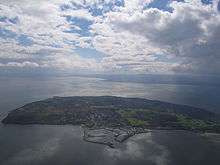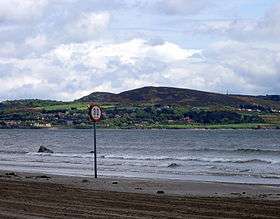Howth Head

_Admiralty_Chart_of_1875_updated_to_1931%2C_copyright_expired_1981.jpg)
Howth Head (Ceann Bhinn Éadair in Irish) is a peninsula northeast of Dublin City in Ireland. Howth falls under the local governance of Fingal County Council. Entry to the headland is at Sutton while the village of Howth and the harbour are on the northern shore. Baily Lighthouse is on the southeastern part of Howth Head. Nearby are the districts of Baldoyle and Portmarnock.
History
The earliest mention of the peninsula was on a map attributed to Claudius Ptolemy, where it was called Edri Deserta or in Greek Edrou Heremos. Here it was portrayed as an island, but it is not clear if this was due to actual separation from the headland or inaccurate information available to the cartographer.
Location
Originally an island, Howth Head is connected to the mainland via a narrow strip of land, or tombolo, and forms the northerly bound of the great crescent of Dublin Bay, roughly corresponding to Killiney Hill in the south.
Nature
Most of the headland is hilly, with peaks such as the 171 m Black Linn, by the Ben of Howth, on a side road beyond the Green Hill Quarries at the Loughereen Hills, Shielmartin Hill (163 m) overlooking Carrickbrack Road, and Carrickbrack and Dun Hill. There are also craggy areas such as and Muck Rock (Carrickmore), and Kilrock, and there are steep sea cliffs around parts, especially on the north coast. Gorse grows in many places on the headland. Fires are frequent during dry summers.
The cliffs support a large colony of seabirds, notably razorbill, common guillemot, fulmar, kittiwake and great cormorant. The scrubland above supports several heathland species including skylark, meadow pipit, whitethroat, linnet, stonechat and whinchat. The most commonly seen birds of prey are kestrel, peregrine falcon and common buzzard.
Gallery
-

Howth Head viewed from on the North Bull Island in Dublin Bay
-
Cliffs at Howth Head with Baily Lighthouse in the distance
-
Baily Lighthouse at southeast end of Howth Head
-
.jpg)
Optic from Baily lighthouse, installed in 1902 and removed in 1972 when the lighthouse was modernised
-
Walk on Howth Head
Leisure
As one of the northern termini of the Dublin Area Rapid Transit system (DART), Howth is a popular destination for day-trippers from the capital. Hikers can choose from a wide range of routes, including the Cliff Walk or making for the ancient cairn on one of Howth's several summits. On clear days, the Wicklow Mountains can be seen, with Dublin city below. Slieve Donard, an 852 metre peak in Northern Ireland may also be visible - a distance of 90 km (56 mi). Quite frequently, Snowdon (1,085 m) in Snowdonia National Park in Wales can also be seen - a distance of 138 km (86 mi).
Popular culture
Howth Head is the location where Leopold Bloom proposes to Molly in James Joyce's Ulysses. In the short story Eveline, another work of James Joyce's from the collection, "Dubliners", it is mentioned that Eveline and her family once had a picnic on the Hill of Howth. Howth Head is also central to Joyce's final work, Finnegans Wake, in which one of the principal characters, HCE, is, among other things, representative of the mountain.
Howth Head is also mentioned in the lyrics of the title track of Kate Bush's 1989 album, The Sensual World: '...took six big wheels and rolled our bodies / off of Howth Head and into the flesh, mmh, yes...'. The song is inspired by Molly Bloom's soliloquy in Joyce's "Ulysses".
External links
| Wikimedia Commons has media related to Howth. |
Coordinates: 53°22′45″N 6°04′19″W / 53.37923°N 6.07201°W